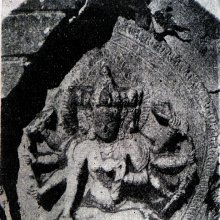Vindhya, Vimdhya: 29 definitions
Introduction:
Vindhya means something in Hinduism, Sanskrit, Jainism, Prakrit, the history of ancient India, Marathi. If you want to know the exact meaning, history, etymology or English translation of this term then check out the descriptions on this page. Add your comment or reference to a book if you want to contribute to this summary article.
Vindhya has 28 English definitions available.
Images (photo gallery)
Languages of India and abroad
Sanskrit dictionary
[Deutsch Wörterbuch]
Source: Cologne Digital Sanskrit Dictionaries: Böhtlingk and Roth Grosses Petersburger WörterbuchVindhya (विन्ध्य):—
1) m. a) Nomen proprium des Gebirges, welches die indische Halbinsel von Ost nach West durchzieht, [Amarakoṣa 2, 1, 8. 3, 3.] [Trikāṇḍaśeṣa 2, 1, 6. 3, 4.] [Hemacandra’s Abhidhānacintāmaṇi 948. 1029.] [Anekārthasaṃgraha 2, 381.] [Medinīkoṣa y. 54.] himavadvindhyayormadhyaṃ yatprāgvinaśanādapi . pratyageva prayāgācca madhyadeśaḥ prakīrtitaḥ .. [Manu’s Gesetzbuch 2, 21.] [Mahābhārata 1, 7625. 7716. 3, 2318. 14, 1173.] [Harivaṃśa 3261. 3275. 5211. 9499. 11448. 12008. 12399.] [Rāmāyaṇa 4, 2, 12. 41, 10.] [Suśruta 1, 172, 6. 2, 169, 3.] [Śārṅgadhara SAṂH. 1, 1, 38.] vindhyastaretsāgaram [Spr. 2853.] [Meghadūta 19.] [Ṛtusaṃhāra.2,28.] [Mālavikāgnimitra 56.] [Varāhamihira’s Bṛhajjātaka S. 12,6. 16,10. 43,35. 69,30.] [Viṣṇupurāṇa 174.] [Mārkāṇḍeyapurāṇa 57,11.] [Oxforder Handschriften 39,b,15.] parvata [Rāmāyaṇa 1, 6, 22.] vindhyādri [Raghuvaṃśa 12, 31.] [Varāhamihira’s Bṛhajjātaka S. 16, 12.] [Kathāsaritsāgara 12, 8.] [Rājataraṅgiṇī 4, 153. 161.] [Vetālapañcaviṃśati] in [Lassen’s Anthologie (III) 31, 5. 6.] vindhyādrinivāsinaḥ [Oxforder Handschriften 82,a, No. 138, Z. 10.] vindhyācala [Varāhamihira’s Bṛhajjātaka S. 12,] Anf. vana [Rāmāyaṇa 4, 48, 2.] vindhyāṭavī [Varāhamihira’s Bṛhajjātaka S. 16, 3.] [Kathāsaritsāgara 7, 25. 10, 115. 18, 96. 42, 97.] [Hitopadeśa 34, 19]; vgl. madhyevindhyāṭavi. taṭavyūḍhavakṣas [Rājataraṅgiṇī 3, 240.] vindhyanivāsinaḥ (so ist zu lesen) [Mārkāṇḍeyapurāṇa 57, 52.] vindhyāntavāsinaḥ die Bewohner des inneren Vindhya [Varāhamihira’s Bṛhajjātaka S. 14, 9.] Der Vindhya, eifersüchtig auf den Meru, weil die Sonne um diesen sich bewegt, erhebt sich um der Sonne den Weg zu versperren, [Mahābhārata.3,8781. fgg.] [Oxforder Handschriften 69,a,7. fgg.] — b) = vyādha Jäger [Hemacandra’s Anekārthasaṃgraha] [Medinīkoṣa] —
2) f. ā a) Averrhoa acida Lin. [Hemacandra’s Anekārthasaṃgraha] [Medinīkoṣa] — b) kleine Kardamomen [Hemacandra’s Anekārthasaṃgraha] — Vgl. nirvindhya, prati, bali .
Sanskrit, also spelled संस्कृतम् (saṃskṛtam), is an ancient language of India commonly seen as the grandmother of the Indo-European language family (even English!). Closely allied with Prakrit and Pali, Sanskrit is more exhaustive in both grammar and terms and has the most extensive collection of literature in the world, greatly surpassing its sister-languages Greek and Latin.
See also (Relevant definitions)
Starts with (+47): Vindhyacala, Vindhyacalavasini, Vindhyacchanda, Vindhyachal, Vindhyachala, Vindhyachchhanda, Vindhyachulika, Vindhyaculika, Vindhyaculuka, Vindhyadatta, Vindhyadhivasini, Vindhyadri, Vindhyadrivasini, Vindhyaga, Vindhyagavasa, Vindhyagiri, Vindhyaka, Vindhyakailasavasini, Vindhyakandara, Vindhyakaumara.
Ends with: Avindhya, Balivindhya, Caruvindhya, Charuvindhya, Nirvindhya, Pancavindhya, Panchavindhya, Prativindhya, Saptavindhya, Shadvindhya, Upavindhya, Vivindhya.
Full-text (+459): Nirvindhya, Vindhyatavi, Pariyatra, Vindhyacala, Vindhyastha, Vindhyavasin, Payoshni, Amarakantaka, Madhyadesha, Aryavarta, Karabhagriva, Sahasrashikhara, Vindhyanilaya, Avindhya, Vindhyadhivasini, Vaindhya, Madhyevindhyatavi, Jalavalaka, Vindhyadri, Vimja.
Relevant text
Search found 107 books and stories containing Vindhya, Vimdhya, Vindhyā, Viṃdhya; (plurals include: Vindhyas, Vimdhyas, Vindhyās, Viṃdhyas). You can also click to the full overview containing English textual excerpts. Below are direct links for the most relevant articles:
Garga Samhita (English) (by Danavir Goswami)
Verse 8.13.76 < [Chapter 13 - A Thousand Names of Lord Balarāma]
Verse 4.10.3 < [Chapter 10 - The Story of the Pulindā Women]
Verse 6.1.15 < [Chapter 1 - Jarāsandha’s Defeat]
Hanuman Nataka (critical study) (by Nurima Yeasmin)
8.2. Mountains in the Hanumannāṭaka < [Chapter 5]
Kavyamimamsa of Rajasekhara (Study) (by Debabrata Barai)
Part 8.3 - Rājaśekhara’s concepts of Bhāratavarṣa (undivided india) < [Chapter 5 - Analyasis and Interpretations of the Kāvyamīmāṃsā]
Appendix 2 - Identification of Geographical names mentioned in the Kāvyamīmāṃsā
Part 8.5 - Region of Dakṣiṇāpatha (southern part) < [Chapter 5 - Analyasis and Interpretations of the Kāvyamīmāṃsā]
Vastu-shastra (5): Temple Architecture (by D. N. Shukla)
Settlement in Early Historic Ganga Plain (by Chirantani Das)
Part 6 - Agriculture of the Vārāṇasī region < [Chapter V - Rise of Vārāṇasī as a Nodal Centre]
Part 2 - Neolithic-Chalcolithic material Culture of the Vindhya-middle Gaṅgā Plains < [Chapter VI - Vārāṇasī: Emergence of the Urban Centre and Seat of Administration]
Part 3 - Lithic industry of the Vārāṇasī region < [Chapter VI - Vārāṇasī: Emergence of the Urban Centre and Seat of Administration]
The Matsya Purana (critical study) (by Kushal Kalita)
Part 2 - Rivers and Mountains of Bhāratavarṣa < [Chapter 8 - Geographical data in the Matsyapurāṇa]
Geographical Aspects of the Purāṇas (Introduction) < [Chapter 8 - Geographical data in the Matsyapurāṇa]
Part 1 - Bhūvanakoṣa: Geography of Seven Continents (saptadvīpā) < [Chapter 8 - Geographical data in the Matsyapurāṇa]
Related products




